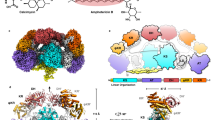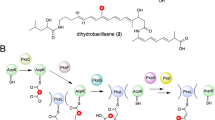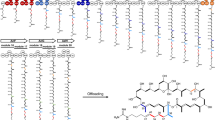Abstract
Modular polyketide synthases (PKSs) are biosynthetic assembly lines that construct structurally diverse natural products with wide-ranging applications in medicine and agriculture. Various mechanisms contribute to structural diversification during PKS-mediated chain assembly, including dehydratase (DH) domain-mediated elimination of water from R and S-configured 3-hydroxy-thioesters to introduce E- and Z-configured carbon–carbon double bonds, respectively. Here we report the discovery of a DH domain variant that catalyzes the sequential elimination of two molecules of water from a (3R, 5S)-3,5-dihydroxy thioester during polyketide chain assembly, introducing a conjugated E,Z-diene into various modular PKS products. We show that the reaction proceeds via a (2E, 5S)-2-enoyl-5-hydroxy-thioester intermediate and involves an additional universally conserved histidine residue that is absent from the active site of most conventional DH domains. These findings expand the diverse range of chemistries mediated by DH-like domains in modular PKSs, highlighting the catalytic versatility of the double hotdog fold.

This is a preview of subscription content, access via your institution
Access options
Access Nature and 54 other Nature Portfolio journals
Get Nature+, our best-value online-access subscription
$29.99 / 30 days
cancel any time
Subscribe to this journal
Receive 12 print issues and online access
$259.00 per year
only $21.58 per issue
Buy this article
- Purchase on Springer Link
- Instant access to full article PDF
Prices may be subject to local taxes which are calculated during checkout





Similar content being viewed by others
Data availability
The minimum dataset necessary to interpret, verify and extend the research is provided in the main paper, extended data and supplementary information. The corresponding raw data (Figs. 2–5, Extended Data Figs. 1 and 2, Supplementary Table 1 and Supplementary Figs. 4 and 5), which were processed via standard deconvolution (intact protein mass spectrometry) and extracted ion chromatogram (LC–MS analyses) procedures, are available upon written request to the corresponding author.
References
Newman, D. J. & Cragg, G. M. Natural products as sources of new drugs over the last 25 years. J. Nat. Prod. 70, 461–477 (2007).
Staunton, J. & Weissman, K. J. Polyketide biosynthesis: a millennium review. Nat. Prod. Rep. 18, 380–416 (2001).
Hertweck, C. The biosynthetic logic of polyketide diversity. Angew. Chem. Int. Ed. 48, 4688–4716 (2009).
Keatinge-Clay, A. T. Stereocontrol within polyketide assembly lines. Nat. Prod. Rep. 33, 141–149 (2016).
Shah, D. D., You, Y.-O. & Cane, D. E. Stereospecific formation of E- and Z-disubstituted double bonds by dehydratase domains from modules 1 and 2 of the fostriecin polyketide synthase. J. Am. Chem. Soc. 139, 14322–14330 (2017).
Skiba, M. A. et al. Structural basis of polyketide synthase O-methylation. ACS Chem. Biol. 13, 3221–3228 (2018).
Walker, P. D., Weir, A. N. M., Willis, C. L. & Crump, M. P. Polyketide β-branching: diversity, mechanism and selectivity. Nat. Prod. Rep. 38, 723–756 (2021).
Meoded, R. A. et al. A polyketide synthase component for oxygen insertion into polyketide backbones. Angew. Chem. Int. Ed. 57, 11644–11648 (2018).
Xie, X. & Cane, D. E. Stereospecific formation of Z-trisubstituted double bonds by the successive action of ketoreductase and dehydratase domains from trans-AT polyketide synthases. Biochemistry 57, 3126–3129 (2018).
Jenner, M. et al. Mechanism of intersubunit ketosynthase–dehydratase interaction in polyketide synthases. Nat. Chem. Biol. 14, 270–275 (2018).
Li, Y. et al. Functional characterization of a dehydratase domain from the pikromycin polyketide synthase. J. Am. Chem. Soc. 137, 7003–7006 (2015).
Nazi, I., Koteva, K. P. & Wright, G. D. One-pot chemoenzymatic preparation of coenzyme A analogues. Anal. Biochem. 324, 100–105 (2004).
Agarwal, V. et al. Chemoenzymatic synthesis of acyl coenzyme A substrates enables in situ labeling of small molecules and proteins. Org. Lett. 17, 4452–4455 (2015).
Worthington, A. S. et al. One-pot chemo-enzymatic synthesis of reporter-modified proteins. Org. Biomol. Chem. 4, 44–46 (2006).
Quadri, L. E. et al. Characterization of Sfp, a Bacillus subtilis phosphopantetheinyl transferase for peptidyl carrier protein domains in peptide synthetases. Biochemistry 37, 1585–1595 (1998).
Labonte, J. W. & Townsend, C. A. Active site comparisons and catalytic mechanisms of the hot dog superfamily. Chem. Rev. 113, 2182–2204 (2012).
Belecki, K. & Townsend, C. A. Biochemical determination of enzyme-bound metabolites: preferential accumulation of a programmed octaketide on the enediyne polyketide synthase CalE8. J. Am. Chem. Soc. 135, 14339–14348 (2013).
Jumper, J. et al. Highly accurate protein structure prediction with AlphaFold. Nature 596, 583–589 (2021).
Wagner, D. T. et al. Structural and functional trends in dehydrating bimodules from trans-acyltransferase polyketide synthases. Structure 25, 1045–1055 (2017).
Xie, X. & Cane, D. E. pH-Rate profiles establish that polyketide synthase dehydratase domains utilize a single-base mechanism. Org. Biomol. Chem. 16, 9165–9170 (2018).
Fiers, W. D., Dodge, G. J., Sherman, D. H., Smith, J. L. & Aldrich, C. C. Vinylogous dehydration by a polyketide dehydratase domain in curacin biosynthesis. J. Am. Chem. Soc. 138, 16024–16036 (2016).
Wilson, K. E. et al. Difficidin and oxydifficidin: novel broad spectrum antibacterial antibiotics produced by Bacillus subtilis. II Isolation and physico-chemical characterization. J. Antibiot. 40, 1682–1691 (1987).
Tang, L. et al. Elucidating the mechanism of cis double bond formation in epothilone biosynthesis. J. Am. Chem. Soc. 126, 46–47 (2004).
Dodge, G. J. et al. Structural and dynamical rationale for fatty acid unsaturation in Escherichia coli. Proc. Natl Acad. Sci. USA 116, 6775–6783 (2019).
Pöplau, P., Frank, S., Morinaka, B. I. & Piel, J. An enzymatic domain for the formation of cyclic ethers in complex polyketides. Angew. Chem. Int. Ed. 52, 13215–13218 (2013).
Berkhan, G. & Hahn, F. A dehydratase domain in ambruticin biosynthesis displays additional activity as a pyran-forming cyclase. Angew. Chem. Int. Ed. 53, 14240–14244 (2014).
Kusebauch, B., Busch, B., Scherlach, K., Roth, M. & Hertweck, C. Functionally distinct modules operate two consecutive α,β→β,γ double-bond shifts in the rhizoxin polyketide assembly line. Angew. Chem. Int. Ed. 49, 1460–1464 (2010).
Gay, D. C., Spear, P. J. & Keatinge-Clay, A. T. A double-hotdog with a new trick: structure and mechanism of the trans-acyltransferase polyketide synthase enoyl-isomerase. ACS Chem. Biol. 9, 2374–2381 (2014).
Berkhan, G., Merten, C., Holec, C. & Hahn, F. The interplay between a multifunctional dehydratase domain and a C-methyltransferase effects olefin shift in ambruticin biosynthesis. Angew. Chem. Int. Ed. 55, 13589–13592 (2016).
Wagner, D. T. et al. Structural and functional studies of a pyran synthase domain from a trans-acyltransferase assembly line. ACS Chem. Biol. 13, 975–983 (2018).
SP, N. et al. Mining symbionts of a spider-transmitted fungus illuminates uncharted biosynthetic pathways to cytotoxic benzolactones. Angew. Chem. Int. Ed. 59, 7766–7771 (2020).
Acknowledgements
This research was supported by the Biotechnology and Biological Sciences Research Council (grant nos. BB/L021692/1, BB/K002341/1 and BB/M017982/1 to G.L.C.). M.J. and D.G. were supported by a Biotechnology and Biological Sciences Research Council Discovery Fellowship (grant no. BB/R012121/1) and the EPSRC MOAC Doctoral Training Centre (grant no. EP/F500378/1), respectively. M.R.-C. was supported by a mobility grant from the Government of Andorra (grant no. AM025-AND-2015). C.H. was supported by a PhD studentship from the University of Warwick. G.L.C. was the recipient of a Wolfson Research Merit Award from the Royal Society (grant no. WM130033).
Author information
Authors and Affiliations
Contributions
M.J., C.H. and G.L.C. designed the study. C.H. D.M.R. and M.R.-C. synthesized the pantetheine thioesters. M.J. overproduced and purified all recombinant proteins. M.J. and C.H. conducted substrate loading and LC–MS analyses of intact proteins. X.J. conducted the cysteamine-mediated product cleavage experiments. M.J. and D.G. conducted bioinformatics analyses. M.J., C.H. and G.L.C. wrote the paper with input from the other authors.
Corresponding author
Ethics declarations
Competing interests
D.M.R. is an employee and shareholder of Erebagen Ltd. G.L.C. is a Non-Executive Director, shareholder and paid consultant of Erebagen Ltd. The other authors declare no competing interests.
Peer review
Peer review information
Nature Chemical Biology thanks Kira Weissman and the other, anonymous, reviewer(s) for their contribution to the peer review of this work.
Additional information
Publisher’s note Springer Nature remains neutral with regard to jurisdictional claims in published maps and institutional affiliations.
Extended data
Extended Data Fig. 1 Activity of the DH-like domain from module 13 of the gladiolin PKS towards 3S, 5S and 3S, 5R-configured stereoisomers of the natural substrate.
a, Deconvoluted mass spectrum of the DH-ACP di-domain following conversion of pantetheine thioester 12 to the corresponding CoA thioester and loading onto the apo-ACP domain. Negligible dehydration is observed. b, Deconvoluted mass spectrum of the DH-ACP di-domain following conversion of pantetheine thioester 13 to the corresponding CoA thioester and loading onto the apo-ACP domain. While a small quantity of mono-dehydrated product is observed, the major product is the holo-di-domain, which likely results from offloading of the substrate by δ-lactonization. The stereochemistry of the putative 2-enoyl-5-hydroxy and 2, 4-dienoyl thioesters resulting from single and double dehydration of the ACP thioesters derived from 12 and 13 are tentatively assigned based on established stereochemical relationships for other PKS DH domains (that is, R-configured hydroxyl groups result in E-configured alkenes and S-configured hydroxyl groups result in Z-configured alkenes). These stereochemical assignments could not be experimentally confirmed due to the very small quantities of singly and doubly dehydrated species produced.
Extended Data Fig. 2 Activity of the DH-like domain from module 13 of the gladiolin PKS towards the 3R, 5R-configured stereoisomer of the natural substrate.
a, Deconvoluted mass spectrum of the DH-ACP di-domain following conversion of pantetheine thioester 14 to the corresponding CoA thioester and loading onto the apo-ACP domain, showing the formation of singly and doubly dehydrated products. b, Extracted ion chromatograms (EICs) at m/z = 247.09 ± 0.02 from LC-MS comparisons of the cysteamine adducts of the 2, 4-dienoyl thioester resulting from double dehydration of the (3R, 5R)-3,5-dihydroxyacyl-ACP thioester by the DH-like domain (top) with synthetic standards of (2E, 4Z) (middle) and (2E, 4E)-2,4-dienoyl (bottom) panthetheine thioesters (10 and 11, respectively). c, Deconvoluted mass spectrum of the DH-ACP di-domain following conversion of pantetheine thioester 11 to the corresponding coenzyme A thioester and loading onto the apo-ACP domain, showing the formation of primarily a singly hydrated species. d, Deconvoluted mass spectrum of the DH-ACP di-domain following conversion of thioester 16 to the corresponding coenzyme A thioester and subsequent loading onto the apo-ACP domain, showing the formation of primarily the 2, 4-dienoyl thioester. All experiments were performed in triplicate and representative data are shown. e, Proposed mechanism for conversion of the (3R, 5R)-3,5-dihydroxyacyl-ACP thioester derived from 14 to the corresponding (2E, 4E)-2,4-dienoyl thioester by the DH-like domain. Hydrogen bonding of the C-3 and C-5 hydroxyl groups to Asp200 orients the substrate for E, E-diene formation.
Extended Data Fig. 3 Comparison of a model of the DH-like domain from module 13 of the gladiolin PKS with the structure of the DH-like domain from module 11 of the difficidin PKS and conservation of twin active site His residues in putative diene-forming DH-like domains from trans-AT PKSs.
a, Overlay of the AlphaFold model of the DH-like domain from the gladiolin PKS with the X-ray crystal structure of the DH-like domain from the difficidin PKS, highlighting the near identical positioning of the Asp and two His active site residues. b, Regions from a sequence alignment encompassing the two His residues observed in the active sites of the DH-like domains from the gladiolin and difficidin PKSs (H23/25 and H158/155, respectively), highlighting that they are universally conserved in other putative diene-forming DH-like domains from trans-AT PKSs. The labelling of DH-like domains corresponds to the subunit names and module numbers illustrated in Supplementary Fig. 1 (for example, Gbn_M13 is the DH-like domain from module 13 of GbnD5 subunit of the gladiolin PKS).
Extended Data Fig. 4 Mechanism of DH domain-catalyzed dehydration of 3-hydroxyacyl-ACP thioesters.
a, Dehydration of (3R)-3-hydroxyacyl thioesters yields the corresponding (2E)-2-enoyl thioester. b, Dehydration of (3S)-3-hydroxyacyl thioesters yields the Z-configured product. These reactions proceed via an E1CB mechanism involving a conserved active site His residue, which acts a general base / acid, and involve a net syn-elimination of the C-3 hydroxyl group and Hb. Hydrogen bonding of the C-3 hydroxyl group to a conserved active site Asp residue orients it in a gauche conformation with respect to Hb.
Extended Data Fig. 5 Sequence alignment of DH-like domains in cis-AT and trans-AT PKSs.
R1, R2 and R3 are residues corresponding to H44, Y168 and D206, respectively, of the DH domain from the EryAII subunit of the 6-DEB PKS (labelled EryDH1 in the figure). The functional group(s) introduced by each type of domain in trans-AT PKSs are shown to the left of the alignments. DH domains are labelled according to the order they appear in the PKS (that is, going from the N to C-terminus the first DH domain is labelled DH1, the second DH2 and so forth).
Extended Data Fig. 6 Phylogenetic analysis of DH-like domains in trans-AT and cis-AT PKSs.
Neighbor-joining tree constructed from the sequences of DH-like domains from characterized trans-AT and cis-AT PKSs. Colored clades correspond to different catalytic functions in trans-AT PKSs, as follows: blue - 2-enoyl thioester synthases (DHe domains); red - 2, 4-dienoyl thioester synthases (DHd domains); green - 2-enoyl thioester isomerases (DHi domains); orange – tetrahydropyran/tetrahydrofuran synthases, (DHt domains). R1, R2 and R3 are the three conserved active site residues in the diene forming DH-like domains from trans-AT PKSs and the corresponding residues in other types of DH-like domain (see Extended Data Fig. 5). The structurally characterized DH-like domain from module 11 of the difficidin PKS (labelled DifDH8) and DH-like domain from module 13 of the gladiolin PKS (labelled GbnDH5) studied here are marked with asterisks, and examples of DH-like domains where the configuration of the diene in the final product differs from the predicted 2E, 4Z-configuration of the 2,4-dienoyl thioester intermediate are marked with black squares. An X between the DH and ACP domains indicates the presence of one or more other catalytic domains. DH domains are labelled according to the order they appear in the PKS (that is, going from the N to C-terminus, the first DH domain is labelled DH1, the second DH2 and so forth).
Supplementary information
Supplementary Information
Supplementary Table 1, Figs. 1–5 and Note.
Rights and permissions
Springer Nature or its licensor holds exclusive rights to this article under a publishing agreement with the author(s) or other rightsholder(s); author self-archiving of the accepted manuscript version of this article is solely governed by the terms of such publishing agreement and applicable law.
About this article
Cite this article
Hobson, C., Jenner, M., Jian, X. et al. Diene incorporation by a dehydratase domain variant in modular polyketide synthases. Nat Chem Biol 18, 1410–1416 (2022). https://doi.org/10.1038/s41589-022-01127-y
Received:
Accepted:
Published:
Issue Date:
DOI: https://doi.org/10.1038/s41589-022-01127-y



